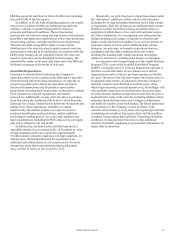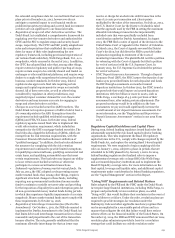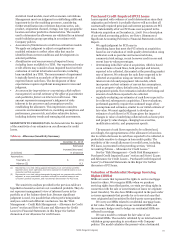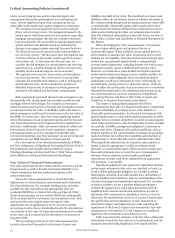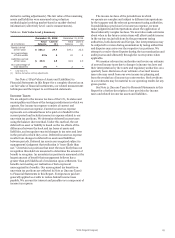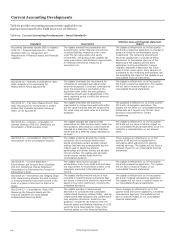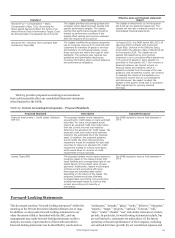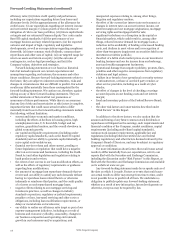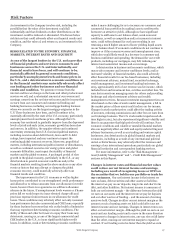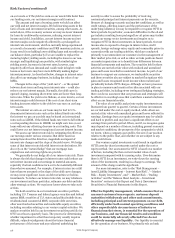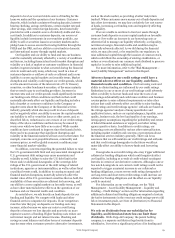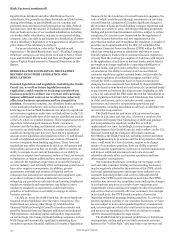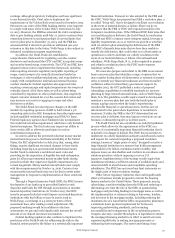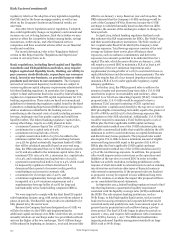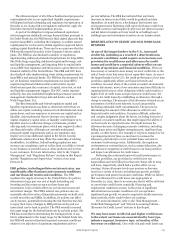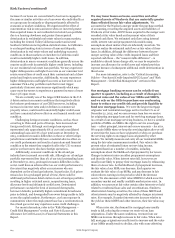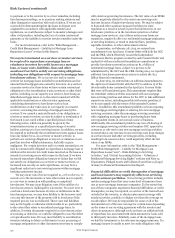Wells Fargo 2015 Annual Report Download - page 119
Download and view the complete annual report
Please find page 119 of the 2015 Wells Fargo annual report below. You can navigate through the pages in the report by either clicking on the pages listed below, or by using the keyword search tool below to find specific information within the annual report.
Risk Factors
An investment in the Company involves risk, including the
possibility that the value of the investment could fall
substantially and that dividends or other distributions on the
investment could be reduced or eliminated. We discuss below
risk factors that could adversely affect our financial results and
condition, and the value of, and return on, an investment in the
Company.
RISKS RELATED TO THE ECONOMY, FINANCIAL
MARKETS, INTEREST RATES AND LIQUIDITY
As one of the largest lenders in the U.S. and a provider
of financial products and services to consumers and
businesses across the U.S. and internationally, our
financial results have been, and will continue to be,
materially affected by general economic conditions,
particularly unemployment levels and home prices in
the U.S., and a deterioration in economic conditions or
in the financial markets may materially adversely affect
our lending and other businesses and our financial
results and condition. We generate revenue from the
interest and fees we charge on the loans and other products and
services we sell, and a substantial amount of our revenue and
earnings comes from the net interest income and fee income that
we earn from our consumer and commercial lending and
banking businesses, including our mortgage banking business
where we currently are the largest mortgage originator in the
U.S. These businesses have been, and will continue to be,
materially affected by the state of the U.S. economy, particularly
unemployment levels and home prices. Although the U.S.
economy has continued to gradually improve from the depressed
levels of 2008 and early 2009, economic growth has been slow
and uneven. In addition, the negative effects and continued
uncertainty stemming from U.S. fiscal and political matters,
including concerns about deficit levels, taxes and U.S. debt
ratings, have impacted and may continue to impact the
continuing global economic recovery. Moreover, geopolitical
matters, including international political unrest or disturbances,
as well as continued concerns over energy prices and global
economic difficulties, may impact the stability of financial
markets and the global economy. A prolonged period of slow
growth in the global economy, particularly in the U.S., or any
deterioration in general economic conditions and/or the
financial markets resulting from the above matters or any other
events or factors that may disrupt or dampen the global
economic recovery, could materially adversely affect our
financial results and condition.
The improvement in the U.S. economy as well as higher
home prices contributed to our strengthened credit performance
and allowed us to release amounts from our allowance for credit
losses, however there is no guarantee we will have allowance
releases in the future. If unemployment levels worsen or if home
prices fall we would expect to incur elevated charge-offs and
provision expense from increases in our allowance for credit
losses. These conditions may adversely affect not only consumer
loan performance but also commercial and CRE loans, especially
for those business borrowers that rely on the health of industries
that may experience deteriorating economic conditions. The
ability of these and other borrowers to repay their loans may
deteriorate, causing us, as one of the largest commercial and
CRE lenders in the U.S., to incur significantly higher credit
losses. In addition, weak or deteriorating economic conditions
make it more challenging for us to increase our consumer and
commercial loan portfolios by making loans to creditworthy
borrowers at attractive yields. Although we have significant
capacity to add loans to our balance sheet, weak economic
conditions, as well as competition and/or increases in interest
rates, could soften demand for our loans resulting in our
retaining a much higher amount of lower yielding liquid assets
on our balance sheet. If economic conditions do not continue to
improve or if the economy worsens and unemployment rises,
which also would likely result in a decrease in consumer and
business confidence and spending, the demand for our credit
products, including our mortgages, may fall, reducing our
interest and noninterest income and our earnings.
A deterioration in business and economic conditions, which
may erode consumer and investor confidence levels, and/or
increased volatility of financial markets, also could adversely
affect financial results for our fee-based businesses, including
our investment advisory, mutual fund, securities brokerage,
wealth management, and investment banking businesses. In
2015, approximately 26% of our revenue was fee income, which
included trust and investment fees, card fees and other fees. We
earn fee income from managing assets for others and providing
brokerage and other investment advisory and wealth
management services. Because investment management fees are
often based on the value of assets under management, a fall in
the market prices of those assets could reduce our fee income.
Changes in stock market prices could affect the trading activity
of investors, reducing commissions and other fees we earn from
our brokerage business. The U.S. stock market experienced all-
time highs in 2015, but also experienced significant volatility and
there is no guarantee that high price levels will continue. Poor
economic conditions and volatile or unstable financial markets
also can negatively affect our debt and equity underwriting and
advisory businesses, as well as our trading and venture capital
businesses. Any deterioration in global financial markets and
economies, including as a result of any international political
unrest or disturbances, may adversely affect the revenues and
earnings of our international operations, particularly our global
financial institution and correspondent banking services.
For more information, refer to the “Risk Management –
Asset/Liability Management” and “– Credit Risk Management”
sections in this Report.
Changes in interest rates and financial market values
could reduce our net interest income and earnings,
including as a result of recognizing losses or OTTI on
the securities that we hold in our portfolio or trade for
our customers. Our net interest income is the interest we
earn on loans, debt securities and other assets we hold less
the interest we pay on our deposits, long-term and short-term
debt, and other liabilities. Net interest income is a measure of
both our net interest margin – the difference between the yield
we earn on our assets and the interest rate we pay for deposits
and our other sources of funding – and the amount of earning
assets we hold. Changes in either our net interest margin or the
amount or mix of earning assets we hold could affect our net
interest income and our earnings. Changes in interest rates can
affect our net interest margin. Although the yield we earn on our
assets and our funding costs tend to move in the same direction
in response to changes in interest rates, one can rise or fall faster
than the other, causing our net interest margin to expand or
contract. If our funding costs rise faster than the yield we earn
Wells Fargo & Company
117


